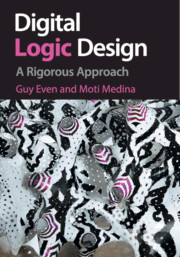18 - Memory Modules
from PART III - SYNCHRONOUS CIRCUITS
Published online by Cambridge University Press: 05 November 2012
Summary
In this chapter, we present circuits that serve as memory modules. The first type of circuit, called a parallel load register, is simply built of identical copies of clock-enabled flip-flops. The second type, called a shift register, remembers the input from k clock cycles ago. Such a shift register is build from k clock-enabled flip-flops connected in chain.
We also consider memory circuits. The first circuit, called a Random Access Memory (RAM), is capable of storing and reading values. It is like a blackboard divided into many cells. We can write a value in each cell, and we can read the value written in a cell. When we write in a cell, it erases the previous value so that only the new value is written in the cell. The second memory circuit is called a Read-Only Memory (ROM). It is like a blackboard on which a value has been written in each cell with permanent ink. The contents of each cell cannot be erased or written over, and we can only read values stored in the cells.
The functionality of a flip-flop is complicated and following the timing is tedious. Instead, we propose an abstract model called the zero delay model. In this simplified model, all transitions are instantaneous. The zero delay model enables us to separate between functionality and timing so that we can focus on functionality.
Information
- Type
- Chapter
- Information
- Digital Logic DesignA Rigorous Approach, pp. 264 - 271Publisher: Cambridge University PressPrint publication year: 2012
